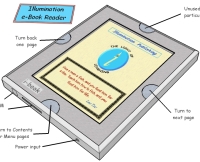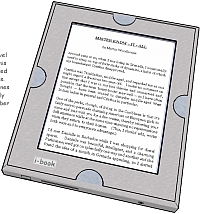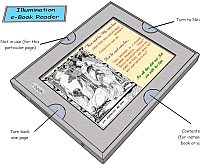Around two months ago I proposed, in these pages, a $50 e-book reader for distribution to OLPC's (and Nicholas Negroponte's) original target population, the poor of the World who have neither shoes no electricity and for whom 'school' is a scarce and sporadic luxury.
You can go back to my original article to see why I, and now others (including many of you, perhaps) feel that OLPC has lost its way in a street-market of fairly nice, fairly cheap laptops for nice, tidy Asian classrooms. It's enough to note that such is the case.
After my first proposal back then, though, I have been concerned in case it might appear that -- as we say in sunny England -- I am 'all mouth and no trousers'. So, if you will allow me, may I here present an update on where the Illumination Book Reader has got to?
In the past two months, then, I have designed both its interior and exterior, several pictures of which are shown here. It is, as you see, very simple in concept and appearance, with Mary Lou Jepsen's screen on its front, along with four buttons placed so that they are neatly accessible by your thumbs when you are holding the Reader exactly as you would hold a paperback book.
The buttons at either side of the screen -- whichever way up the latter is orientated, I should add -- are used to turn one page forward or back. The button at the foot takes you to the contents list (and any other menus which the book may need, such as an index) and the top one is an on-off switch.
The pages themselves, as you can see, are in colour or black-and-white and can contain text in any language or font size. I've included one 'plain text' page -- it's from a short story of mine -- purely to show that in this mode (novel, textbook, article) a page will hold around twenty-five lines and (say) 250 words.
Again, this is pretty much like a paperback. As shown here and in a CAD picture, the text itself doubtless appears too small to be readable, but I have tested it upon a group of several elderly ladies whose most frequent (and gratifying) comment has been "It's lovely, I can read it without my glasses . . ."
On one side of the Reader are two 'slots'. Each is for inserting an e-book --- or, rather, and entire library of up to a thousand e-books, since Illumination's own proprietary format holds around 300 pages of text and illustrations in around a megabyte. The wide slot is for a current RAM card; the square hole will be (later) for the I-Reader's own RAM 'sticks' which will hold the same amount of reading material as the card but will be less breakable.
I envisage that, as can be done with current USB RAM sticks, you will in the Western world keep several of these on your key-ring; when you buy your morning newspaper and magazines -- or a book -- for reading on the train, you will simply plug one of them into a socket at the newsagent's counter.
The third, round socket is the (auxiliary) power input for charging the Reader's batteries. It's 'auxiliary' because, for our fifty dollars' manufacturing cost, we will also get the only piece of the I-Reader not shown here, namely its lid, which will include its main power unit, a solar panel.
This, (always assuming I have got my calculations roughly right) will yield around four and a half watt-hours per day, against which the mean power consumption of the Reader itself should be less than half a watt.
Nicholas Negroponte's team is shooting for 2 Watts for the XO and is in fact now running at around 9 Watts, so I gather. I am shooting for a mean of 0.2 Watts, or ten times less, but Murphy's Law tells us we won't get down that low for a while.
All right. May I leave more technical details for the Reader until another article? This has been just an introduction, because I wanted to show that I haven't been sitting on my thumbs, and because it's always nice to see a few pictures. Right now, I shall be very interested to read all initial comments and criticisms you may offer, and I will also try to put together answers to any questions you may have.
Assuming this machine is a runner -- and I will listen carefully to your views on this, even if I happen to think she's a little beauty -- well, look, she had better get built and distributed, together with a whole lot of books of evey conceivable kind and for every age, to those millions of children in the Third World who were originally supposed to benefit from the XO, the Classmate, the Eeee or whatever? Yes?
This is the bit, of course, that I can't do for myself. Creative, yes, I can do creative okay, and technical I can take a shot at, but business sense or knowledge? I have zippo. Zilch
I am an eccentric, not to say bloody-minded, old bastard on a hilltop in Surrey. I've designed the hardware and software by myself, and I have a younger business partner, not to mention a bright bloke a few miles away who can cobble together a prototype. But, in the absence of funding, that is where we shall be stuck.
And I have to tell you that I have so far received zero interest, let alone support, from any organisation with a few million bucks to invest in Third World education. That includes, I am sorry to have to tell you, OLPC itself, whom I first approached in March and from whom -- and only after much prodding from myself -- I have received merely a short and dismissive reply.
Well, it's a tough old world, of course, and big bucks are big bucks, and all that stuff. But I still think it's a bit sad. On the other hand, maybe OLPC reads OLPC News? Let's see.
Because in any case, I did mention the term 'bloody-minded', didn't I? Along with 'old' (I'm seventy- five next month if anyone feels like sending me a birthday card for August 29th). And, believe me, I am -- maybe we are -- going to get this thing built and launched, one way or another.
Bet on it. The fifty-dollar Reader is coming at ya, boys, and that means 'fifty dollars and no extras, and falling downwards as volumes increase', not kind of drifting up surrounded by press releases..






Sounds really great! It will, of course, have its own market.
What text formats will be available?
PDF? ODF reader? PS? (X)HTML?
An ODF reader should be available:
http://opendocumentfellowship.org/odfviewer
As is a firefox plugin:
https://addons.mozilla.org/en-US/firefox/addon/1888
It would be a kick-start if the reader could be used for Project Gutenberg.
Winter
Martin, I certainly think it can be a wonderful thing. There are plenty of instances where I believe it would be quite more useful than a computer, no matter how sophisticated.
Besides committing to buy one (or a few) when it comes to light, what else you think it's needed to make it work?
"since Illumination's own proprietary format holds around 300 pages of text and illustrations in around a megabyte."
Do the world really need another proprietary format? Why not using standard formats? I honestly don't believe that Illumination is better than others, mostly because we know very little about it. So is a comparison between Illumination and other formats (PDF, DejaVU, HTML, XML, OpenDocument), available or either being done?
I am asking this considering the cost of production of the ebooks themselves. A new format would not be necessarily cheap for publishers to support...
Hi
Well, I can see I need to deal with the technical specs pretty soon rather than just with the appearance of this little beast; I wil do so fully ASAP, but for now:-
The Illumination Reader uses its own format for books, that is to say, "Illumination". This is a book-creation suite with its own 'reader' software, which is written and compiled into MSDOS. The whole thing -- the reader, the reading software and all of the books -- thus forms a single unit, or concept.
Illumination, for instance, won't do anything other than anything other than read (or write) a book in Illumination format; and no other piece of software except Illumination can read an Illumination book.
This approach is of course highly unusual in these times, but has several quite large advantages. So far as I know, for instance, no other page format can put a complete 300-page illustrated book into just a megabyte of memory space; and this in turn is because all the Illumination reading software doesn't have to do anything except take a page out of memory (around 2 to 6 Kb) and bang it onto the screen in the form of coloured pixels.
Nothing else, no internet, no games, no keyboard, no mouse, no Windows, no overheads except DOS (FreeDOS will do nicely), nothing except a 40Kb reading program itself written in DOS.
(Every Illumination book, in fact, contains its own version of the reading program -- and this in turn will make it pretty easy to copy-proof, keep out viruses, etc.)
And all this, in its turn, means a power consumption of less than half a watt for the book-reader itself, which in turn means it can be powered by a solar PV panel . . .
Look, it's a 1990's piece of work, the whole damn thing, and although this implies some weaknesses it also, surprisingly as things turn out, carries some quite enormous strengths with it.
But the thing for me to get across right now is that every single book, in whatever language, which is read on one of these little beasts is gong to have to be translated into Illumination format --- which, fortunately, is extremely easy to do even for a non-computer person.
(It's been done, in fact, for a 200-page comic book called NERVOUS SYSTEM, whose author-artist had, in 1990, indeed never touched a PC in his life, and it only took me 4 hours to teach him all he needed to know, after which he went away with a borrowed PC and simply wrote it . . .
Enough for now --- ask more questions and I will answer them ...
Cheers, Martin
Hi all
"Minimalist." That's the word I was looking for. It's jolly minimalist and so is the whole thinking which surrounds it.
( Er . . . and also, one hates to be boring and all, but it's pretty green too. Dormouse-sized carbon footprint, I shouldn't wonder. )
Luv
Martin (and apologies for any typos)
I'm willing to bet big bucks that Martin has little more than a few drawings and an idea.
To put together the kind of product he has described takes more than a few months and a 'bright bloke a few miles away'.
Developing a 'proprietary format' is also something that smells of smoke and magic and is easy to pull out of a bag of tricks.
Martin, come back when you have a working prototype.
As far as the 'book reader' concept goes, I'd like to point out their inadequacy as a learning tool specially for young children or students. The power behind the OLPC idea is the creativity and learning loop in the activities, not a passive reading activity. Thats where products like the XO will take children beyond reading what others have written and actually contributing their own works.
For the dollar value (or Pounds sterling) the XO hardware and software package is worth more than a book reader.
Looks good. I wouldn't mind having one myself.
However, remember that the plan is to have the olpc down to $50 in a few years. And no doubt it will have competitors with similar capabilities and similar prices.
Remember, an ebook reader is basically a crippled computer. It has a cpu, memory, display, and input ports. But it is lacking a few other things like a keyboard and built-in storage (and in the case of olpc, mesh networking and human-supplied power).
That is important because if you add the missing parts in, you raise the cost maybe 25-50% but increase the functionality more than ten times. So a fully functional computer, once it is affordable, is a much more efficient investment for most people.
Kudos for Martin for his initiative, but I am afraid that I have to agree with Robert (above). Until there is a working prototype, what are we really talking about here? A design which features as its most critical technology component (the clock-stopping hot screen, to borrow some of Wayan's hyperbole) something that is simply to be taken from OLPC. This would seem to me to be a non-starter. A new proprietary page/file format ... this sounds rather ominous. (A nice touch, compiling into MS-DOS!) Whatever you feel about Negroponte and Co. (and opinions on this messageboard appear decidedly mixed), you can not but admire the fact that they have actually built a working product from scratch, in a remarkably short amount of time, which is going out into the marketplace. With with statements like "the thing for me to get across right now is that every single book, in whatever language, which is read on one of these little beasts is gong to have to be translated into Illumination format --- which, fortunately, is extremely easy to do even for a non-computer person" I don't wonder is Mr. Woodhouse is just having a laugh at all of us here.
Sorry to be a pain, but I have more concerns:
"to be translated into Illumination format --- which, fortunately, is extremely easy to do even for a non-computer person."
More details? Is there going to be a "back-end" conversion tool that accept any text format and delivers a fully encapsulated "binary" for the e-reader?
What about old books, for which no e-version is available. Those will most likely need to be scanned and converted. DjVY was designed just for this. How's the new format going to handle this issue?
What about figures, images, diagrams, formulas? Science is not simple text, but to be fully understood, it needs to be visualized. From what you describe, using DOS as a base may sound great for efficiency, but I don't think it will provide the ability to show appropriately graphics, formulas, and diagrams. Am I missing something?
Dear All:
Ancient Chinese Proverb:
"Person saying it can't be done should not interrupt person doing it."
=====================================================
I'm terribly sorry, people, but I already have around twenty Illumination books, each on a single diskette, each containing its own reading program, and each running on a fifteen year old computer under MSDOS.
If anyone would like a copy of one of these books --- "A MIDSUMMER NIGHT'S DREAM" , laid out in colour by myself and gorgeously illustrated, also in colour, by David Pinnell --- all they have to do is send me US$25 and a postal address and I will send them one by return of post. Oh, and they will also need a similarly ancient PC running a version of Windows no later than 98 --- because, of course, later versions of Windoze won't run DOS properly.
Or:- You can have a copy of my own textbook on calculus, "NEXT DOOR TO NOTHING"; this is also fully illustrated in colour with graphs, diagrams, etc . . .
Or indeed, "NERVOUS SYSTEM", the wholly pictorial comic book I have mentioned above, created (in colour) by Andy Roberts . . .
---------
All twenty of these books, all of them illustrated in colour and several containing Flash-like animation, are currently running on the aforesaid ancient DOS machine standing three feet away from me on my desk.
( You can see all of this stuff on my website at
www.martin-woodhouse.co.uk )
---------
As for the reader itself: I have a schedule of all the components needed (including the solar panel and Mary Lou Jepson's screen) with current prices, and I reckon that the actual cost of the complete Reader will be well under $50 --- and probably in quantities of 250,000 plus, around thirty bucks? (I admit I am not a production engineer and that's therefore a bit of a guess.)
--------
Hi Martin, Good to learn of your work. Are you familiar with our work on the Includer? http://www.includer.org A proposed device for reading and writing emails on a USB flash drive. We're working on it at http://groups.yahoo.com/group/learnhowtolearn/ I invite you and all to join us there. Perhaps we'd find synergies?
i want the latop